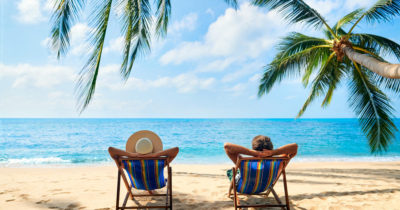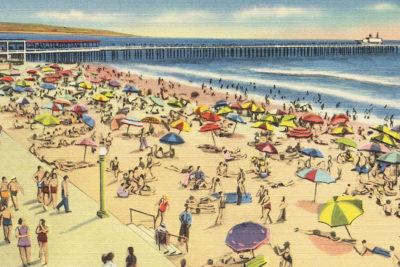
Searcy, AR (LP) — Summer is the hottest of the four temperate seasons, falling after spring and before autumn. At or around the summer solstice, the earliest sunrise and latest sunset occurs, the days are longest and the nights are shortest, with day length decreasing as the season progresses after the solstice. The last day of summer is September 20th. While sunny skies and warm temperatures do more than make our environment a pleasant place. They also provide some very significant benefits to our health and well being. Research indicates that you are less likely to die of a heart attack in the summer than in the winter.
In spring the weather usually turns warmer, trees begin to grow their leaves, plants start to flower and young animals such as chicks and lambs are born. In summer the weather is usually warm, trees have full green leaves and the amount of time it is light for during the day is longer. Mrs. Farhatt says, “I do household projects that I haven’t had time to complete during the school year.” Summer came from the Old English name for the season “sumor”, which in turn came from the Proto-Germanic *sumur-, which itself came from the Proto-Indo-European root *sam-, meaning summer. Mrs. Stafford says, “The first thing I enjoy doing in the summer is QUIT SETTING AN ALARM CLOCK! lol By then, I usually have a list of books I want to read, Netflix shows I want to binge watch, and projects around my house I need/want to do. The summer is usually when I get to go see my mom and other family in Mississippi for a week or two.” Warmth of the summer days creates lifelong conditions for animals and plants activities. Also be ready for the thunderstorms, because in the summer it is a very important phenomenon. It helps nature to survive in this hot period, crops to grow better and later give harvest.
Summer break is around 10–11 weeks, either from the end of May to early August, early June to Mid-August, or the end of June to the day after Labor Day in early September depending on region and state. Mrs. Farhatt says, “My family usually goes to the beach in Florida. This year, we are going to the British Isles. “ The “traditional midpoint” of the summer season is August 1st, which is marked on some Christian calendars as Lammas Day, one of the four traditional “cross-quarter” days midway between the solstices and the equinoxes. Mrs. Stafford says, “Yes, but usually not far. Where my family lives is just four hours away.” According to this definition, each season begins on the first of a particular month and lasts for three months: Spring begins on March 1, summer on June 1, autumn on September 1, and winter on December 1. Mrs. Farhatt says, “I spend time with family in St. Louis, Fayetteville, Little Rock, and Conway. We hike Arkansas and Missouri State Parks and try restaurants in various places around the state.” the season between spring and autumn, in the Northern Hemisphere from the summer solstice to the autumnal equinox, and in the Southern Hemisphere from the winter solstice to the vernal equinox. Mrs. Stafford says, “Mississippi” Reckoning by cultural festivals, the summer season in the United States is traditionally regarded as beginning on Memorial Day weekend (the last Weekend in May) and ending on Labor Day (the first Monday in September), more closely in line with the meteorological definition for the parts of the country that have four.
When the North Pole of the Earth is tilted toward the Sun, we in the northern hemisphere receive more sunlight and it’s summer. As the Earth moves in its orbit, the tilt of the North Pole changes. When it is tilted away from the Sun, it is winter in the northern hemisphere. Mrs. Farhatt says, “I often sleep in, but I don’t stay up late.” Although the exact origins of the term are uncertain, it was perhaps so-called because it was first noted in regions inhabited by American Indians, or because the Indians first described it to Europeans, or it had been based on the warm and hazy conditions in autumn when American Indians hunted. Mrs. Stafford says, “I will stay with my mom, but while she is at work, I go visit my dad’s brothers and my cousins.” My favorite season of the year is summer because of the warm weather, the school vacation, and the endless fun. I really enjoy the warm weather because it’s the perfect atmosphere to do outdoor activities. When summer time starts, you can wear lighter clothes, which are much more comfortable. Mrs. Farhatt says, “My family occasionally plays board games and cards, but usually we do something outdoors like hiking and sightseeing.” The length of daytime and nighttime, and our exposure to light have such an enormous effect on our biological clocks, levels of serotonin (which effects our mood), and levels of melatonin (which work with mood and sleep). It’s easy to understand why summer is such a better time for many of us. Mrs.Stafford says, “SLEEP IN AND STAY UP LATE lol. Usually I am up late reading and binge watching shows.” My favorite season is winter, because there’s a lot of snow, and it’s cold outside, and it’s just beautiful. When the countryside is covered with snow, it’s just perfectly white, and I think that’s amazing. Also, I love to build snowmen, have snowball fights with my friends, so that is definitely my favorite season. Mrs. Stafford says, “We don’t really have any games that we play. Our favorite thing to sit around and do together that is similar to that is telling Alexa what song to play next. We love listening to music. Before the night is over, we will have listened to music from ALL genres and time periods.” Winter is by far the best season ever! When you think about it, Fall is the actual normal season. Winter is cold, summer is hot, and spring is rainy. But Fall is just right.

Snowcones, slushies, Slurpees, popsicles, fruit bars, ice cream, frozen yogurt. If it’s cold and sweet, you can bet we’ll be eating it this summer! When the sun is hot it’s fun to indulge in a frozen sweet treat to cool you down. In Svalbard, Norway, which is the northernmost inhabited region of Europe, the sun shines continuously from April 10 to August 23. Visit the region and live for days, for there is no night. Don’t forget to get a peek of the northern lights when visiting. Generally speaking, we’ve predicted that summer temperatures will be hotter than normal, with the hottest periods in mid-June, mid- to late July, and early August. Rainfall will be below normal in the north and above normal in the south. June sets the tone for the season.
